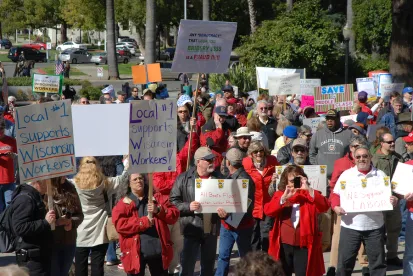We recently saw interesting decisions from the NLRB including cases about the employer’s duty to provide information about tax cuts, the lawfulness of litigation holds, and the validity of decertification petitions.
At the end of December, a divided NLRB took on a case involving a union’s threat to picket a work location where multiple employers are present.
In IBEW Local 357 (Convention Technical Services), 367 NLRB No. 61 (December 27, 2018), the Board addressed the legality of threats made against neutral employers. These are secondary boycott cases implicating Section 8(b)(4) of the Act. A secondary boycott case involves a union with a dispute with one employer (the principal), seeking to target the principal and also broadly publicize the dispute to the public, landlords where the work is being performed, and other employers (secondary targets). The aim of these protests unquestionably is to enmesh as many other secondary targets as possible. Secondary activity is very common and is lawful in a variety of contexts. Anyone who has encountered a banner on the street which states “shame on x company” is viewing secondary activity. The company named in the banner may have nothing at all to do with the hiring of the targeted employer but is being publicly shamed in the hopes that it will exert pressure on the actual target to resolve the dispute. Another fairly common example of lawful secondary activity is the placement of a large, inflatable rat at the jobsite. These publications of a dispute generally have been deemed to be lawful because they do not contain coercive elements, such as picketing.
Secondary boycott activity can be unlawful if the picketing (or other activity with coercive elements) is aimed at neutral employees or companies. These cases usually involve picketing of a construction site.
What made this recent case notable is that the General Counsel and the Respondent union, although usually opponents in litigation, both sought the same result–to overturn Board precedent finding certain threats to picket to be unlawful in violation of Section 8(b)(4).
Background
The charging party is a contractor furnishing portable electrical services in the convention industry. A union targeted the contractor in a dispute over “area standards” (which, ostensibly, is a protest that the contractor does not pay wages and benefits in accordance with similar jobs in the area, usually union, but is widely regarded as code for “non-union”). The contractor was performing some work at the Las Vegas Convention Center. The union sent a letter to the area Trades Council seeking a “strike sanction” against the contractor for “any and all jobs because of not paying area standards.” The letter was copied to the Las Vegas Convention and Visitors Authority, the governmental agency managing the convention center where the work is located.
Charging party filed charges alleging that the union’s letter violated Section 8(b)(4)(B) of the Act because the threat to picket did not state that it would be limited to the charging party in accordance with the standards set forth in Sailors Union of the Pacific (Moore Dry Dock), 92 NLRB 547 (1950). Moore Dry Dock held that picking at a common situs (one where multiple employers are present) is presumptively lawful if:
- “(a) the picketing is strictly limited to times when the situs of the dispute is located on the secondary employer’s premises.” So, no picketing when the target is not present, which helps explain why a banner, which is not inherently coercive, can be displayed any time.
- “(b) at the time of the picketing the primary employer [the target] is engaged in its normal business at the situs.” That is, the target is performing the disputed work.
- “(c) the picketing is limited to places reasonably close to the situs”; thus, if the worksite has a gate “reserved” for the target employer, then the picketing must be limited to the reserved gate; and
- “(d) the picketing discloses clearly that the dispute is with the primary employer.” The picket signs must identify which company is being targeted. Again, contrast this with the banner, which can identify a company with a tenuous connection to the dispute and not mention the target at all.
The General Counsel and Respondent union sought reversal of Board case law holding that threats to picket multi-employer job sites violate the Act if they do not contain assurances that the picketing will be limited to the targeted employer. An example of the case law the parties sought to overturn was Sheet Metal Workers Local 15 (Brandon Regional Medical Center), 346 NLRB 199, 202 (2006), enf. denied 491 F.3 429 (D.C. Cir. 2007) where the Board held that the purpose of the Board’s requirement that a union give Moore Dry Dock assurances is to “assure the secondary employer that the picketing will be confined to the primary employer.”
The ALJ held that although both the D.C. and 9th Circuit courts of courts of appeal had criticized the Board’s rule, he was constrained by the existing precedent and issued a decision finding a violation of the law.
The ALJ’s Decision issued in 2014.
The General Counsel and Respondent appealed.
Divided Board Sticks With Rule
Chairman Ring and Member Kaplan upheld the violation, noting “[f]or over 50 years, the Board has held that if a union notifies neutral employers at a common situs that it intends to picket the primary employer, the union” has an affirmative obligation to qualify its threat by clearly stating its action will conform to the Moore Dry Dock standards. The Board majority concluded that “a union’s broadly worded and unqualified notice, sent to a neutral employer, that the union intends to picket the worksite the neutral shares with the primary employer is inherently coercive.” In this case, the union’s letter stated that the union would seek a strike sanction against “any and all jobs” without any attempt to narrow the scope of the protest.
The Board, anticipating further challenge to its rule on appeal, noted that it was not presuming that the union’s threat was to picket in an unlawful manner. The Board held that the following circumstances, taken together, violated Section 8(b)(4)(B): “the locale of the threatened picketing (a worksite shared by the primary employer and one or more neutral employers), the target of the picketing (one of the neutrals), and the threat’s unqualified and therefore ambiguous nature (leaving the neutral uncertain whether picketing at the common situs will be lawfully confined to the primary or will unlawfully enmesh the neutral)…” Indeed, the letter was copied to the manager of the convention center, the representatives of which might read the threat as an intent to engage in picketing designed to disrupt all of its operations not just the work engaged in by the charging party.
The Board emphasized that it was merely “prohibiting unions from issuing an unqualified threat to engage in common situs picketing” and that it did “not expect unions to necessarily cite Moore Dry Dock or use any specific legalese.” Rather, the union must make clear “in some manner that it will comply with legal limitations on common situs picketing so as to not entangle neutrals.”
Dissent Sees It Differently
Member McFerran dissented, noting that her colleagues missed an “opportunity to revise the Board’s Moore Dry Dock -assurances doctrine in response to the thoughtful criticisms brought by both the courts of appeals and the General Counsel.”
Takeaways
The Board has decided to continue its policy of holding an unrestricted threat to picket as unlawful. Most threats of a job action aimed at a contractor usually contain language limiting the nature of the coercive activity (such as picketing) to the target. Even if this case represented a big change to the law, which it most certainly does not, the requirement to issue a qualified as opposed to an unqualified threat to picket hardly seems onerous.
The real story, in this case, is its backstory. It does seem unusual that the General Counsel and the Respondent would be aligned on seeking the same outcome. One can imagine that the charging party wondering why, after filing an unfair labor practice charge, participating in an investigation of the charge, and having a complaint issue and proceed to litigation, have the NLRB side with the respondent.
Seeking to change existing precedent is fairly common and not confined to any particular ideology. The General Counsel in office in 2014 wanted to change this precedent due to the criticisms of various federal appeals courts. We have discussed how the current General Counsel has stated that one of his priorities is to seek out cases in litigation that can be used to change the law.
Just as the General Counsel has changed since 2014, so has the make-up of the Board. There is little doubt that the outcome of the case would have been different had the Board reached a decision on this case in the two-plus years between the ALJ’s Decision in July 2014 and the change in administration.



 />i
/>i

